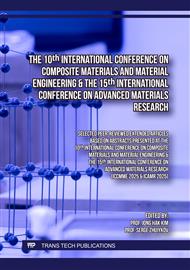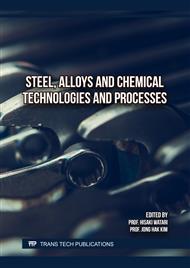[1]
G. Xu et al., 'Enhanced oil recovery performance of surfactant-enhanced Janus SiO2 nanofluid for high temperature and salinity reservoir', Colloids Surf A Physicochem Eng Asp, vol. 657, Jan. 2023.
DOI: 10.1016/j.colsurfa.2022.130545
Google Scholar
[2]
T. Yin, Z. Yang, Z. Dong, M. Lin, and J. Zhang, 'Physicochemical properties and potential applications of silica-based amphiphilic Janus nanosheets for enhanced oil recovery', Fuel, vol. 237, p.344–351, Feb. 2019.
DOI: 10.1016/j.fuel.2018.10.028
Google Scholar
[3]
L. J. Giraldo, 'Janus nanoparticles for enhanced oil recovery EOR: Reduction of interfacial tension', Proceedings - SPE Annual Technical Conference and Exhibition, vol. 2018-September, Sep. 2018.
DOI: 10.2118/194033-stu
Google Scholar
[4]
T. Yin, Z. Yang, Z. Dong, M. Lin, and J. Zhang, 'Physicochemical properties and potential applications of silica-based amphiphilic Janus nanosheets for enhanced oil recovery', Fuel, vol. 237, p.344–351, Feb. 2019.
DOI: 10.1016/j.fuel.2018.10.028
Google Scholar
[5]
P. Liu et al., 'Functional Janus-SiO2 nanoparticles prepared by a novel "cut the gordian knot" method and their potential application for enhanced oil recovery', ACS Appl Mater Interfaces, vol. 12, no. 21, p.24201–24208, May 2020.
DOI: 10.1021/acsami.0c01593
Google Scholar
[6]
L. Yue, W. Pu, T. Zhao, J. Zhuang, and S. Zhao, 'A high performance magnetically responsive Janus nano-emulsifier: Preparation, emulsification characteristics, interfacial rheology, and application in emulsion flooding', J Pet Sci Eng, vol. 208, p.109478, 2022.
DOI: 10.1016/j.petrol.2021.109478
Google Scholar
[7]
L. Hong, S. Jiang, and S. Granick, 'Simple method to produce Janus colloidal particles in large quantity', Langmuir, vol. 22, no. 23, p.9495–9499, Nov. 2006.
DOI: 10.1021/la062716z
Google Scholar
[8]
F. Zhang et al., 'Study of Pickering emulsions stabilized by Janus magnetic nanosheets', Colloids Surf A Physicochem Eng Asp, vol. 654, p.130194, Dec. 2022.
Google Scholar
[9]
M. W. Andriyan, N. Ayu, K. Umiati, V. Gunawan, and A. Subagio, 'Synthesis and Characterization Nanosilica from Geothermal Waste by Wet Grinding Method as an Enhanced Oil Recovery (EOR)', Key Eng Mater, vol. 920, p.146–152, Mar. 2022.
DOI: 10.4028/p-f67gqe
Google Scholar
[10]
M. W. Andriyan, A. H. Hanifah, A. D. Maharani, P. Widiastuti, N. Nadhiroh, and A. Subagio, 'Effectiveness comparison of wet grinding method and sol-gel method to synthesis ZnO nanoparticle for remazol yellow degradation', in AIP Conference Proceedings, American Institute of Physics, Jun. 2024, p.1–7.
DOI: 10.1063/5.0219068
Google Scholar
[11]
H. Wu et al., 'Silica-based amphiphilic Janus nanofluid with improved interfacial properties for enhanced oil recovery', Colloids Surf A Physicochem Eng Asp, vol. 586, Feb. 2020.
Google Scholar
[12]
H. Jia et al., 'Potential application of novel amphiphilic Janus-SiO2 nanoparticles stabilized O/W/O emulsion for enhanced oil recovery', Colloids Surf A Physicochem Eng Asp, vol. 622, p.126658, Aug. 2021.
DOI: 10.1016/j.colsurfa.2021.126658
Google Scholar
[13]
K. M. Jasim, R. N. Ali, and A. H. Al-Hamdani, 'A study on the optical properties of the PMMA polymer doped with some semi metal dioxides nanoparticles', in Journal of Physics: Conference Series, IOP Publishing Ltd, Sep. 2021.
DOI: 10.1088/1742-6596/1999/1/012139
Google Scholar
[14]
Y. Bai, C. Pu, S. Liu, X. Li, L. Liang, and J. Liu, 'A novel amphiphilic Janus nano-silica for enhanced oil recovery in low-permeability reservoirs: An experimental study', Colloids Surf A Physicochem Eng Asp, vol. 637, p.128279, Mar. 2022.
DOI: 10.1016/j.colsurfa.2022.128279
Google Scholar
[15]
A. P. Tchameni et al., 'A novel responsive stabilizing Janus nanosilica as a nano plugging agent in water-based drilling fluids for exploiting hostile shale environments', Pet Sci, vol. 21, no. 2, p.1190–1210, Apr. 2024.
DOI: 10.1016/j.petsci.2023.10.008
Google Scholar
[16]
S. Tang et al., 'Preparation of amphiphilic Janus-SiO2 nanoparticles and evaluation of the oil displacement effect', ACS Omega, vol. 9, no. 5, p.5838–5845, Jan. 2024.
DOI: 10.1021/acsomega.3c08979
Google Scholar
[17]
F. W. Tavares, D. Bratko, and J. M. Prausnitz, 'The role of salt–macroion van der Waals interactions in the colloid–colloid potential of mean force', Curr Opin Colloid Interface Sci, vol. 9, no. 1–2, p.81–86, Aug. 2004.
DOI: 10.1016/j.cocis.2004.05.008
Google Scholar
[18]
Y. Du et al., 'Novel analytical expressions for determining van der Waals interaction between a particle and air–water interface: Unexpected stronger van der Waals force than capillary force', J Colloid Interface Sci, vol. 610, p.982–993, Mar. 2022.
DOI: 10.1016/j.jcis.2021.11.157
Google Scholar
[19]
A. Dani, M. Yeganeh, and C. Maldarelli, 'Hydrodynamic interactions between charged and uncharged Brownian colloids at a fluid-fluid interface', J Colloid Interface Sci, vol. 628, p.931–945, Dec. 2022.
DOI: 10.1016/j.jcis.2022.08.084
Google Scholar
[20]
F. Sagala, A. Hethnawi, and N. N. Nassar, 'Integrating silicate-based nanoparticles with low-salinity water flooding for enhanced oil recovery in sandstone reservoirs', Ind Eng Chem Res, vol. 59, no. 37, p.16225–16239, Sep. (2020)
DOI: 10.1021/acs.iecr.0c02326
Google Scholar
[21]
W. Xue, H. Yang, and Z. Du, 'Synthesis of pH-responsive inorganic Janus nanoparticles and experimental investigation of the stability of their Pickering emulsions', Langmuir, vol. 33, no. 39, p.10283–10290, Oct. 2017.
DOI: 10.1021/acs.langmuir.7b02174
Google Scholar



